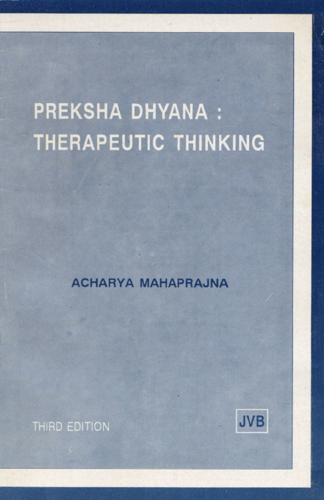Motionless posture of the body - Kāyotsarga—is an essential prerequisite for all types of meditational practice. This can be attained by the release of tensions by relaxation. The success of the exercise of therapeutic thinking will greatly depend on totally relaxed and tensionless state of the body. It is essential for the practitioner to reach the subconscious portion of his mind and this is possible only when he is under deep relaxation and without any mental tension.
In practice, total relaxation is conscious suspension of all gross movements of the body resulting in relaxation of the skeletal muscles and drastic reduction of metabolic activities. This physical condition results in relieving mental tensions and is an essential precondition for meditational practice.
Every muscle in each part of the body is persuaded to relax by auto-suggestion. When the whole body has become relaxed, there is an acute and actual perception of rest and relaxation, which is no longer auto-suggestion, but is real experience. Thus Kāyotsarga is not only deep relaxation but self-awareness and actual contact with the subconscious mind.
Instructions for the Exercise of Total Relaxation
- Keep the spine and neck straight but without stiffness and eyes closed softly. Relax all the muscles of your body and let it become limp.
- Concentrate your mind on each part of the body, one by one. Allow each part to relax, by the process of auto-suggestion and feel that it has become relaxed.
- Starting with the big toe of the right foot, focus your total attention on the toe and suggest to the muscles and nerves to relax; experience the resulting relaxation and pass on to the other parts of the right limb viz, toes, sole, heel, ankle, upper part of the foot, calf-muscles, knee, thigh and buttock. In the same way, relax the left limb upto the hip joint
- Next, relax the trunk from hip joint to the neck starting with the back and the front of the lower abdomen and the upper abdomen going up to the ribs front and back, the chest muscles, collar bone upto the neck muscles. Then relax both limbs from palms to the shoulders i.e. right limb - thumb, fingers, palm, wrist, lower arm, elbow, upper arm and shoulder: left limb—thumb and fingers to shoulders.
- Finally, relax the head from neck to scalp: throat, chin, jaws, lips, tongue, mouth, cheeks, and all the other facial muscles, nose, eyes, ears, temples, forehead and scalp.
- Experience that the whole body is completely, relaxed. Retain the relaxed condition throughout the meditational session.
 Acharya Mahaprajna
Acharya Mahaprajna

